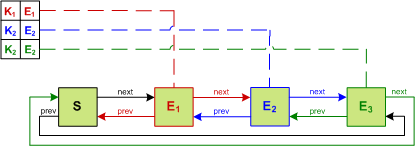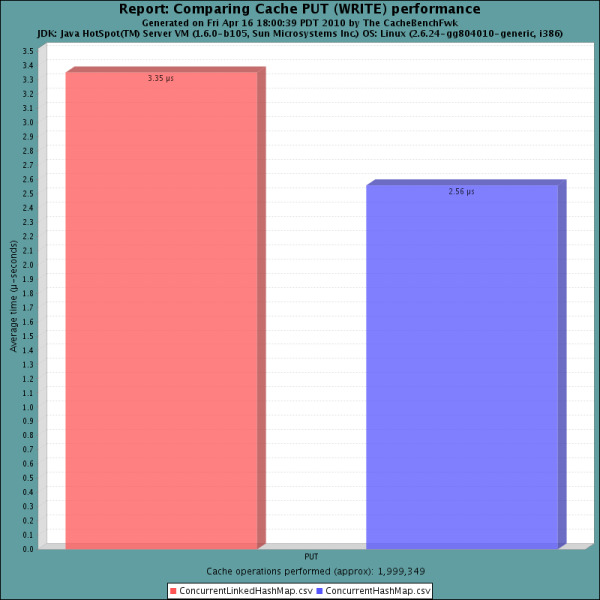简述
ConcurrentLinkedHashMap 是google团队提供的一个容器。它有什么用呢?其实它本身是对
?
ConcurrentHashMap的封装,可以用来实现一个基于LRU策略的缓存。详细介绍可以参见?
?
http://code.google.com/p/concurrentlinkedhashmap
?
使用范例
public static void main(String[] args) {
ConcurrentLinkedHashMap<Integer, Integer> map = new
ConcurrentLinkedHashMap.Builder<Integer,Integer>().maximumWeightedCapacity(2).
weigher(Weighers.singleton()).build();
map.put(1, 1); map.put(2, 2); map.put(3, 3); System.out.println(map.get(1));//null 已经失效了 System.out.println(map.get(2)); }
?
?ConcurrentLinkedHashMap 的构造函数比较特殊,它采用了Builder(构造器,GOF模式之一)。
?
它本身也是实现了ConcurrentMap接口的,所以使用起来跟ConcurrentHashMap一样。我们先put
?
进去三个元素,然后获取第一个元素,果然是null,因为基于LRU(最近使用)算法,key=1的节
?
点已经失效了。
?
源代码解析
先来看看它的整体框架

它本质是额外维护了一个双向链表,每次读和写都要改变相应节点的位置,将其移至队列头。
?
什么时候判断容易已经满了,是根据weight。每个元素都有一个weight,每增加一个元素,weight累计。当达到最大值的时候,就需要剔除最少操作的那个元素了,并且触发相关的事件。
?
我们先来看put函数
?
V put(K key, V value, boolean onlyIfAbsent) {
checkNotNull(value);
final int weight = weigher.weightOf(key, value);//计算weight
final WeightedValue<V> weightedValue = new WeightedValue<V>(value, weight);
final Node node = new Node(key, weightedValue);//对数据进行包装,准备存入
ConcurrentHashMap
for (;;) {
final Node prior = data.putIfAbsent(node.key, node);
if (prior == null) {//这个key之前没有值
afterCompletion(new AddTask(node, weight));//更新后续操作
return null;
} else if (onlyIfAbsent) {
afterCompletion(new ReadTask(prior));
return prior.getValue();
}
?
AddTask 是判断是否容量满了,需要剔除其他元素
final class AddTask extends AbstractTask {
final Node node;
final int weight;
@Override
@GuardedBy("evictionLock")
public void run() {
weightedSize += weight;
// ignore out-of-order write operations
if (node.get().isAlive()) {
evictionDeque.add(node);
evict();//是否移除失效的
}
}
}
void evict() {
while (hasOverflowed()) {
Node node = evictionDeque.poll();
// If weighted values are used, then the pending operations will adjust
// the size to reflect the correct weight
if (node == null) {
return;
}
// Notify the listener only if the entry was evicted
if (data.remove(node.key, node)) {//移除失效的
pendingNotifications.add(node);
}
node.makeDead();
}
}
?
get函数更简单一点,只是将这个key节点移至队列头
public V get(Object key) {
final Node node = data.get(key);
if (node == null) {
return null;
}
afterCompletion(new ReadTask(node));
return node.getValue();
}
?
性能比较 vs ConcurrentHashMap
不用说了,肯定是ConcurrentHashMap要好一点了,因为本文的主角还要维护一个操作队列嘛:)
不过性能上不是差很多,见下图。

总结:
利用ConcurrentLinkedHashMap来做基于LRU的缓存,还是值得推荐的。我们可以定义它的容器大小,基于LRU,就可以保证较高的命中率了。
?
参考资料:
http://code.google.com/p/concurrentlinkedhashmap